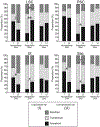Density of Macrophages Immunostained With Anti-iba1 Antibody in the Vestibular Endorgans After Cochlear Implantation in the Human
- PMID: 31335797
- PMCID: PMC6697207
- DOI: 10.1097/MAO.0000000000002313
Density of Macrophages Immunostained With Anti-iba1 Antibody in the Vestibular Endorgans After Cochlear Implantation in the Human
Abstract
Hypothesis: Cochlear implantation may result in an increase in the density of macrophages in vestibular endorgans in the human.
Background: Vestibular symptoms are a common complication of cochlear implantation. In a previous study, we demonstrated histological evidence of a foreign-body response caused by silicon and platinum in the human cochlea following cochlear implantation. The objective of the current study was to seek evidence of a possible immune response in vestibular endorgans after cochlear implantation.
Methods: The density of macrophages immunostained with anti-Iba1 antibody in the vestibular endorgans (lateral and posterior semicircular canals, utricle and saccule) in 10 human subjects who had undergone unilateral cochlear implantation was studied by light microscopy. The densities of macrophages in the neuroepithelium, subepithelial stroma, and among dendritic processes in the mid-stromal zone in four vestibular endorgans in the implanted and the opposite unimplanted ears were compared. The distributions of macrophage morphology (amoeboid, transitional and ramified) were also compared.
Results: The densities of macrophages in implanted ears in four vestibular endorgans were significantly greater than that in opposite unimplanted ears except in the subepithelial zone of the utricle and posterior semicircular canal. In contrast to the neuroepithelium, the subepithelial distribution of amoeboid macrophages in implanted ears was significantly less than in unimplanted ears.
Conclusion: An increase in the density of macrophages in four vestibular endorgans after implantation was demonstrated. The transition among phenotype of macrophages suggested possible migration of amoeboid macrophages from the subepithelial stroma into the neuroepithelium.
Conflict of interest statement
(disclosure)
All authors declare no conflict of interest related to this manuscript.
Figures














Similar articles
-
The Distribution and Prevalence of Macrophages in the Cochlea Following Cochlear Implantation in the Human: An Immunohistochemical Study Using Anti-Iba1 Antibody.Otol Neurotol. 2020 Mar;41(3):e304-e316. doi: 10.1097/MAO.0000000000002495. Otol Neurotol. 2020. PMID: 31821256 Free PMC article.
-
Prevalence of Macrophages Within the Cochlear Vessels Following Cochlear Implantation in the Human: An Immunohistopathological Study Using Anti-Iba1 Antibody.Otol Neurotol. 2021 Dec 1;42(10):e1470-e1477. doi: 10.1097/MAO.0000000000003312. Otol Neurotol. 2021. PMID: 34325451 Free PMC article.
-
Histopathology of the peripheral vestibular system after cochlear implantation in the human.Otol Neurotol. 2006 Jan;27(1):57-64. doi: 10.1097/01.mao.0000188658.36327.8f. Otol Neurotol. 2006. PMID: 16371848
-
Cochlear implantation in children with anomalous cochleovestibular anatomy.Laryngoscope. 2005 Jan;115(1 Pt 2 Suppl 106):1-26. doi: 10.1097/00005537-200501001-00001. Laryngoscope. 2005. PMID: 15626926 Review.
-
Meta-analysis of subjective complaints of vertigo and vestibular tests after cochlear implantation.Laryngoscope. 2018 Sep;128(9):2110-2123. doi: 10.1002/lary.27071. Epub 2018 Jan 4. Laryngoscope. 2018. PMID: 29314057
Cited by
-
Cochlear implant material effects on inflammatory cell function and foreign body response.Hear Res. 2022 Dec;426:108597. doi: 10.1016/j.heares.2022.108597. Epub 2022 Aug 4. Hear Res. 2022. PMID: 35963812 Free PMC article.
-
Mammalian Inner Ear-Resident Immune Cells-A Scoping Review.Cells. 2024 Sep 12;13(18):1528. doi: 10.3390/cells13181528. Cells. 2024. PMID: 39329712 Free PMC article.
-
Immune Response of Macrophage Population to Cochlear Implantation: Cochlea Immune Cells.Otol Neurotol. 2020 Oct;41(9):1288-1295. doi: 10.1097/MAO.0000000000002764. Otol Neurotol. 2020. PMID: 32925862 Free PMC article.
-
Macrophage-related immune responses in inner ear: a potential therapeutic target for sensorineural hearing loss.Front Neurosci. 2024 Jan 11;17:1339134. doi: 10.3389/fnins.2023.1339134. eCollection 2023. Front Neurosci. 2024. PMID: 38274500 Free PMC article. Review.
-
Cochlear implants: Causes, effects and mitigation strategies for the foreign body response and inflammation.Hear Res. 2022 Sep 1;422:108536. doi: 10.1016/j.heares.2022.108536. Epub 2022 May 24. Hear Res. 2022. PMID: 35709579 Free PMC article. Review.
References
-
- Fina M, Skinner M, Goebel JA, Piccirillo JF, Neely JG. Vestibular dysfunction after cochlear implantation. Otol Neurotol. 2003, 24: 234–242. - PubMed
-
- Terry B, Kelt RE, Jeyakumar A. Delayed complications after cochlear implantation. JAMA Otolaryngol Head Neck Surg. 2015, 141: 1012–1017. - PubMed
-
- Ito J Influence of the multichannel cochlear implant on vestibular function. Otolaryngol Head Neck Surg. 1998, 118: 900–902. - PubMed
-
- Kubo T, Yamamoto KI, Iwaki T, Doi K, Tamura M. Different forms of dizziness occurring after cochlear implant. Eur Arch Otorhinolaryngol. 2001, 258: 9–12. - PubMed
Publication types
MeSH terms
Grants and funding
LinkOut - more resources
Full Text Sources

